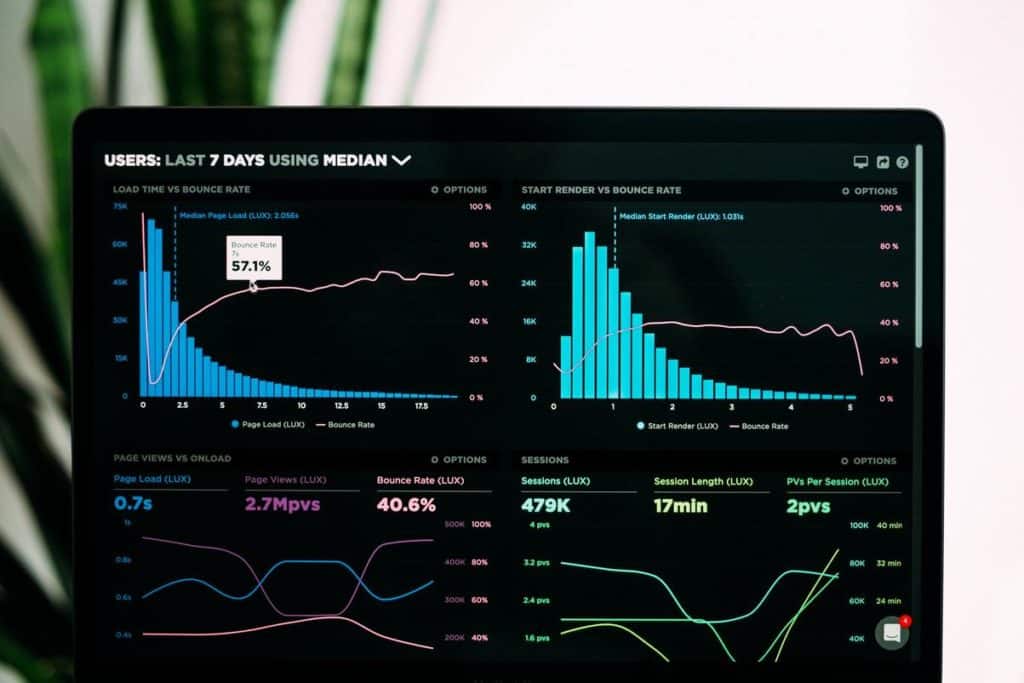Good sales performance indicators should enable you to:
- Gain a comprehensive view of your sales funnel at any given moment
- Identify opportunities to enhance performance
In this article, we highlight ten key indicators that, in our view, best meet these two objectives. If you think we’ve missed any, share your suggestions in the comments!
Sommaire
#1 Total Volume of Leads
The first crucial metric is the total number of leads or opportunities your business generates. Tracking this number helps you assess the effectiveness of your lead generation efforts and identify potential areas for improvement.
When calculating the total volume of leads, consider the following sources:
- Website visitors (available through Google Analytics)
- Confirmed participants in your webinars (registration statistics)
- In-store visits (physical counting)
- Subscribers to your blog or newsletter
- Trade show registrations (event stats), and more.
Diversifying lead sources is essential to ensure a steady and reliable inflow. Once leads are collected, the next step is to qualify them effectively.
Explore Further
- Check out our comparison of the best webinar platforms
- Learn how to host effective webinars to generate more leads
- Get inspired by these 10 successful webinar examples
#2 Email Response Rate
Did you know that the average person deletes 48% of their daily emails? Standing out in a crowded inbox is challenging, but your email response rate offers valuable insights into the effectiveness of your messaging.
A low response rate often signals that your content isn’t resonating with your audience or that you’re targeting the wrong recipients. Monitoring and optimizing this metric helps you refine your email strategy and ensure greater engagement.
#3 MQL to SQL Conversion Rate
Understanding the transition between Marketing Qualified Leads (MQLs) and Sales Qualified Leads (SQLs) is critical for optimizing your sales pipeline. Here’s a quick distinction:
- Marketing Qualified Leads (MQLs): Individuals who’ve shared their information in exchange for content like whitepapers or webinar access.
- Sales Qualified Leads (SQLs): Prospects that align with your “buyer persona” and show strong purchase intent.
This KPI helps assess the effectiveness of your lead nurturing strategies and ensures your sales team focuses on high-potential prospects. Defining a qualified prospect may vary, but it typically involves evaluating their fit and purchase intent.
Explore Further
- MQL vs SQL: What’s the Difference?
- Learn about lead scoring with our complete guide
- Explore our comprehensive guide to lead qualification
#4 Number of Open Opportunities
Tracking sales opportunities provides a snapshot of your progress toward closing deals. By analyzing what happens after opportunities arise (e.g., conversion rates), you can identify which strategies yield the best results.
Measure the number of opportunities generated by each channel across your sales pipeline. Implementing a robust lead nurturing strategy is crucial for maintaining momentum and converting these opportunities into sales.
#5 Quote-to-Sale Conversion Rate
The quote-to-sale conversion rate is a critical indicator of how effective your sales funnel is over time. By comparing your current performance to past data, you can identify whether your strategies are improving or need adjustment.
This metric tracks how many prospects convert after the first, second, or third interaction and highlights the best-performing salespeople. It helps you pinpoint which customer profiles are most likely to convert early in the process and refine your strategies accordingly.
A high conversion rate indicates your sales approach is resonating with your target audience. However, if it drops, it’s time to explore new tactics to encourage prospects to take the desired action.
#6 Number of Contact Points
The number of contact points measures the total interactions—calls, emails, meetings—with a prospect before closing a deal. On average, it takes seven touchpoints to secure a meaningful sales conversation.
Tracking these interactions is crucial not just for improving conversion rates but also for managing the cost of acquisition. The more efficient your touchpoints, the better your chances of closing deals without inflating costs.
#7 Length of Sales Cycle
The length of the sales cycle is a vital KPI for evaluating how well your team manages time and resources. Knowing the average duration for closing deals with qualified prospects helps you plan timelines and allocate tasks effectively.
If any stage in your funnel takes too long, it can negatively impact conversion rates as potential buyers lose interest. Streamlining each phase of the sales cycle minimizes delays, keeps prospects engaged, and drives better results.

#8 Projected Value of Your Sales Funnel
This KPI offers a snapshot of your pipeline’s health, allowing you to gauge whether you’re on track to meet sales targets. By monitoring the projected value of deals in your CRM, you can assess whether your pipeline is robust or requires more input.
Tracking this figure ensures your monthly revenue forecasts are accurate, enabling proactive decision-making when necessary.
Explore Further
- CRM: The Complete Guide
- Check out our B2B CRM Software Comparison
- Learn how much it costs to set up a CRM
#9 Actions Taken by Your Salespeople
Measuring the progress of sales targets is important, but tracking specific actions by your sales team is equally vital for sustained success. When employees see progress tied to their efforts—like follow-up emails, demos, or calls—they remain motivated and engaged.
Track key sales actions to identify which behaviors drive results. This approach not only boosts team morale but also ensures consistent progress toward sales goals.
- Follow-up emails
- Product demos
- Client calls
#10 Social Selling Index
If social selling is part of your funnel, particularly through LinkedIn, tracking the Social Selling Index (SSI) is essential. This metric measures the effectiveness of your team’s social selling strategies.
Social selling is more important than ever:
- 75% of B2B buyers and 84% of senior executives rely on social media for purchasing decisions.
- 98% of salespeople with over 5,000 LinkedIn connections meet or exceed their quotas.
- Social selling generates 38% more new opportunities compared to traditional methods.
The SSI measures four pillars of social selling success:
- Branding: Optimizing profiles, sharing content, and building credibility
- Connections: Engaging prospects through LinkedIn
- Knowledge sharing: Establishing thought leadership
- Relationship building: Fostering long-term connections
Monitoring these KPIs ensures your sales processes are efficient, adaptive, and focused on growth. Share in the comments any additional KPIs you find effective in your sales strategy!






